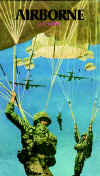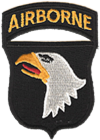
It has been
documented that perhaps no military development has been as revolutionary or
effective as the use of paratroopers.
Brig. Gen. William "Billy" Mitchell conceived the idea of
parachuting troops from aircraft into combat to break the stalemate of trench
warfare on the Western Front during World War I; and just after World War I
arranged a demonstration at Kelly Field, Texas, in which six U.S. soldiers
parachuted from a Martin bomber. In less than three minutes after jumping from
the plane they were on the field and ready for action. But the officials who
observed the event regarded it as only a stunt.
In April 1940, the War Department authorized the formation
of an experimental platoon of airborne infantry, to be tested at Fort Benning by
the Infantry Board.
In July 1940, a parachute test platoon was formed of 48
volunteers of rugged physique from the 29th Infantry, and stationed at Lawson
Field, Fort Benning, Georgia. Later that year the commander of the 2nd Division
was directed to conduct tests to develop reference data and operational
procedures.
The test platoon was immediately sent to Hightstown, N.J. to train on the
250-foot parachute towers built for the 1939 World's Fair. The tower training
was so effective the Army bought the towers and moved them to Fort Benning,
which became the Army's first airborne training center. In August 1940, the
platoon made its first real sky jump from a B-18 bomber. Lt. Wm. T. Ryder was
the first paratrooper out the door, followed by Private William N. King.
Thirteen days later the platoon made the first mass jump.
The 501st Parachute Battalion was activated October 2, 1940, the first
combat paratrooper unit, the cadre coming from the test platoon. The 501st
Battalion was commanded by Major William M. Miley, later a major general in
command of the 17th Airborne Division.
The American paratrooper of World War II fought under tremendous handicaps.
The planes were not capable of carrying heavy equipment, and the trooper had to
make up for it in fighting spirit. His artillery was of the lightest type; and
the only ground transport that he had was what glider could bring in. He had no
tanks, no construction equipment, and no antiaircraft support.
After World War II, however, things greatly improved. With the emphasis on
airborne operations, much more of the airborne trooper�s equipment and supplies
could be brought in by air, and in the future wars he fought in�Korea, Vietnam,
he received even more of the support that a soldier needs to fight effectively
on the ground�supplies, ammunition, artillery, anti-aircraft guns, and even an
entire bridge-were dropped.
OUR AIRBORNE DIVISIONS
THE 11th AIRBORNE
DIVISION is known as the "Angels." During World War II, the "Angels" fought in
the Philippines, on Leyte and Luzon, and rescued 2,000 American and European
prisoners in a daring raid on the Japanese internment camp at Los Banos. The
11th was the first outfit into Tokyo after the Japanese surrendered.
THE 101st AIRBORNE DIVISION, known as the "Screaming Eagles," is best
known for its famous defense of Bastogne when its commander General Tony
McAuliffe replied "Nuts" to the German ultimatum to surrender. The 101st jumped
in Normandy and in Holland and contributed to a large degree to the defeat of
the Axis forces in Western Europe.
THE 82nd AIRBORNE DIVISION is known as the "All-American" Division. In World
War II, it jumped in Sicily, Normandy, and Holland. This famous division fought
magnificently throughout the war in Western Europe. It won high honors in the
Battle of the Bulge and played a major role in cracking the Siegfried Line.
THE 13th AIRBORNE DIVISION was formed late in the war and did not go into
action as a division, although one of its regiments, the famous 517th Parachute
Regiment, fought in Italy and spearheaded the invasion of Southern France. The
13th does not have as long a history as our other airborne divisions, but while
active it showed that it was ready to carry on the airborne tradition.
The American paratrooper of World War II fought under tremendous handicaps.
The planes were not capable of carrying heavy equipment, and the trooper had to
make up for it in fighting spirit. His artillery was of the lightest type; and
the only ground transport that he had was what glider could bring in. He had no
tanks, no construction equipment, and no antiaircraft support.
After World War II, however, things greatly improved. With the emphasis on
airborne operations, much more of the airborne trooper�s equipment and supplies
could be brought in by air, and in the future wars he fought in�Korea, Vietnam,
he received even more of the support that a soldier needs to fight effectively
on the ground�supplies, ammunition, artillery, anti-aircraft guns, and even an
entire bridge-were dropped.
THE KOREAN WAR
The Korean War
operations proved the soundness of post World War II airborne developments. In
Korea, the 187th Airborne Regimental Combat Team was used to cut off fleeing
Communist forces. In addition to being tactically successful, the Korean drops
were significant because the paratroopers were delivered into an amazingly small
area and with greater firepower because planes released the heaviest equipment
ever dropped in combat.
The 101st Airborne Division did not
participate in the Korean War.
THE VIETNAM WAR
American airborne involvement in Southeast Asia saw paratroopers in the thick of the fighting once again. Some went as advisors to train and help form South Vietnamese airborne units. Others went with the 101st Airborne Division, the 82nd Airborne Division, and 173rd Airborne Brigade (Separate), fighting the Communists face to face on the ground in many of the most bloodiest encounters of the war.
